Stan Cassidy – Aviation Enthusiast and Pilot
Flying was one of Stan’s passions. He learned to fly at age 42 and was an active private pilot for the rest of his life. Over the course of 39 years he flew 6377 hours in 35 airplanes, 8 of which he owned personally. The primary motivation for owning an aircraft was in support of his electrical contracting business for which it served very well. It enabled him to serve his customers better and his business thrived as a result.
Stan loved flying in general. He found other uses for his plane such as transporting patients to places like Montreal for medical treatment, taking curling teams to matches around the northeastern US and Canada, attending Masonic and Shrine events, plus the occasional vacation jaunt to places like Florida and Tennessee. He studied and practiced diligently to maintain his flying proficiency. He worked hard at his flying. It was a labor of love.
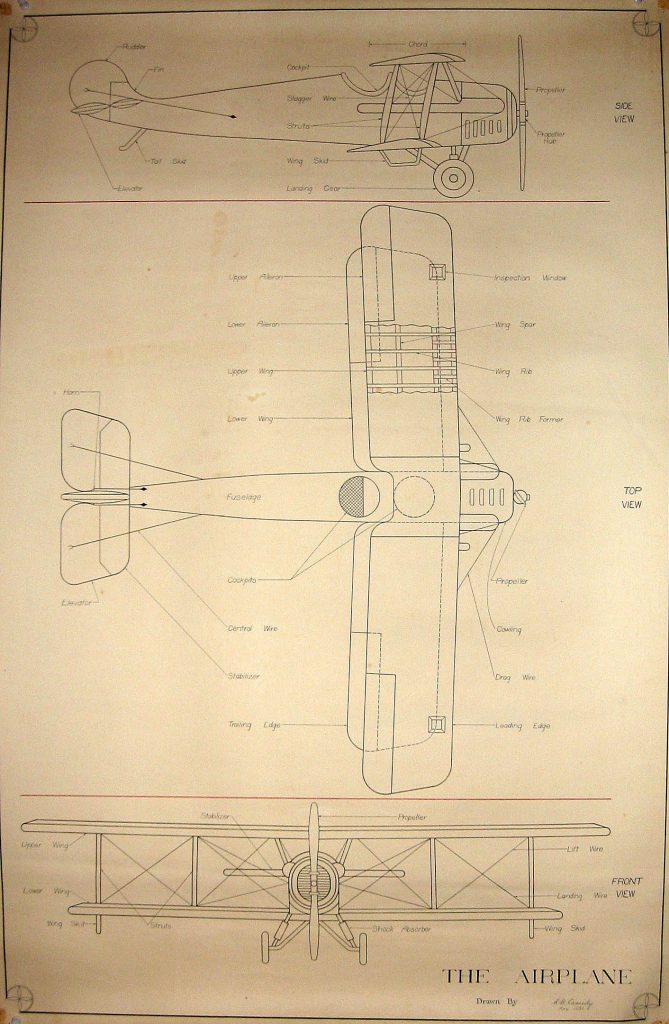
Stan’s interest in aviation probably started very early as witnessed by a drawing he made in 1930 of a biplane. This was probably related to one of his engineering courses at UNB. The quality of his work is extraordinary.
We have all Stan’s pilot log books from first flight in Taylorcraft CF-EHO on April 24, 1954. There are no entries after Dec 1987. However, we have the trip logs he started keeping in 1972 which include all the information that would normally go in his pilot log book. There is no legal requirement to keep a pilot log except to substantiate flight time when applying for a new rating. At age 75, Stan had no plans to seek new ratings so there was no incentive to keep his pilot log book up to date.
Stan’s motivation to fly was to get to places like Montreal, Toronto, Boston, and Halifax to meet with equipment suppliers and pick up urgently needed supplies. Commercial air travel to Fredericton in the 1950s was limited and private aircraft offered a viable alternative. It took some work for him to convince the tax people that his airplane was a legitimate expense, but he managed to do so for his entire 39 year flying career.
Stan’s flying career began in 1954 with the purchase of a two-seat, tail wheel airplane, a 1946 Taylorcraft CF-EHO from Fredericton businessman and personal friend, Gerry Carty. His first training flight in EHO was on April 24, 1954 with his instructor, P.L. Munnings. He soloed four days later on April 28 after only 6:15 hrs of dual instruction. He flew 40 hours and completed training for his private pilot license in less than three weeks on May 13, 1954.
His first passenger after receiving his license was Lloyd Sinclair, one of his employees, on June 12, 1954. His next passenger was his father Allen, on June 13. His son Bruce flew with him on June 14, his mother Edythe on June 15, son Brian on June 15, son Peter on June 17, and his secretary, Al MacMillan (Foster), on June 19.
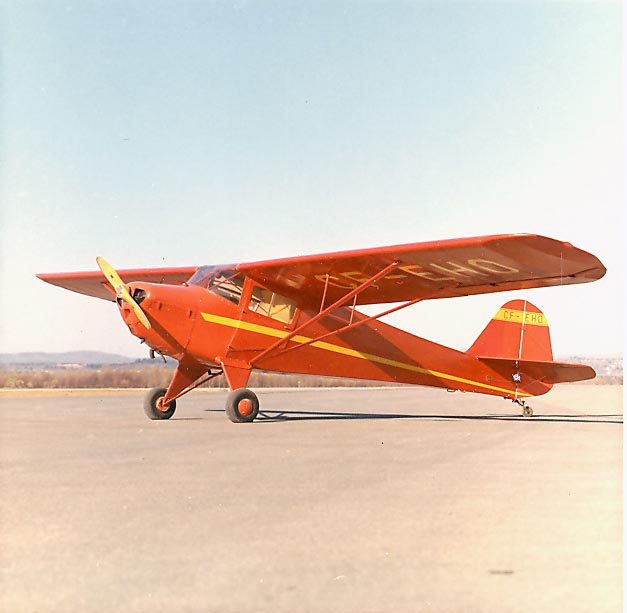
While the Taylorcraft was a good airplane to learn to fly in, it was not sufficient for the needs of his electrical contracting business. For this he had a better aircraft in mind. There were no further flights in the Taylorcraft EHO after July 28 1954 until June 2, 1956 when he flew it to Moncton, presumably to deliver to a new owner. He only flew it actively for a few months, just long enough to get his license and buy a more suitable aircraft. The Canadian aircraft registry shows Taylorcraft CF-EHO still flying and based in Edmonton, Alberta in 2013.
On June 9, 1954 he flew for 1:05 hrs around Boston with Fred Bedell in a 1953 D35 Bonanza, N3425B. A month later, on July 2, he was back in Boston with Fred flying this same Bonanza from Atlantic City, NJ to Allentown, PA to Springfield, to Boston, to Hyannis, and back to Boston. They flew a total of 3:40 hrs, enough to get Stan checked out in the Bonanza. One month later, on August 9, 1954, he was again in Boston with Fred Bedell. This time they flew 4:35 hrs around Boston getting Stan checked out in his new aircraft, Bonanza CF-HTA. He flew CF-HTA home to Fredericton from Boston later that day, a 2:15 hr flight. He now had just 71 hrs in his log book and in just over three months gone from first flight in an entry level trainer to a high performance business aircraft. This speaks well for his flying skills and passion for flying.
Beechcraft introduced the Bonanza in 1947. It represented a major improvement in aircraft performance. It sported a distinctive “V” tail and was top of the line in general aviation airplanes. HTA was a model E35 Bonanza. It would seat 4, had a useful load of 1050 lbs, a 205 hp engine, cruise at 180 mph, and carried 40 gallons of fuel for a range of 775 miles.
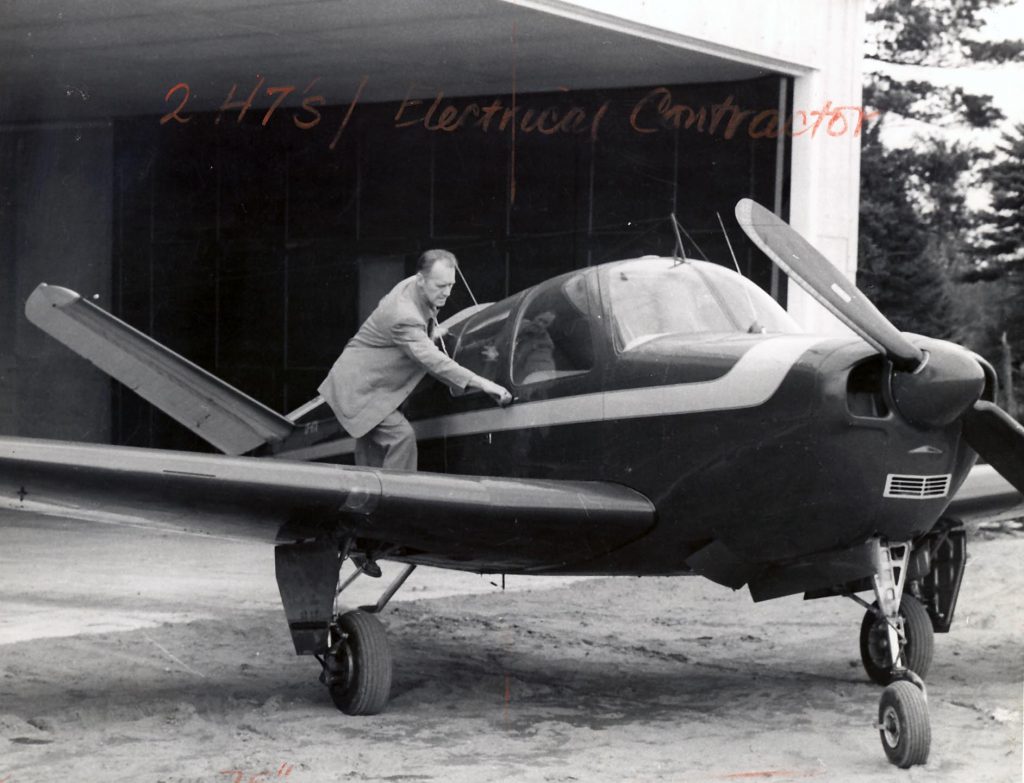
Airplanes need a hangar for maintenance and to protect them from the weather. Fredericton airport had little or no hangar facilities in 1954 so Stan built one that was large enough to hold several airplanes. Construction was started in the fall of 1954 and completed in 1955. About 1957 he sold the hangar to Guy DiGiacinto, a Fredericton business man, who established a flight school and air charter operation. The hangar survived until the early 2000s when it was torn down by the airport authority as part of a renovation project. Fifty years after selling the hangar to Guy DiGiacinto’s, Guy’s grandson, David, married Stan’s granddaughter, Brenda in 2007.
Except for two years when he owned the hangar, Stan’s planes were mostly parked outside. This is surprising since his airplanes were very special and received the best treatment. It’s particularly helpful to have them inside during the winter to protect them from ice and snow. Cleaning snow of a plane is cold, tedious work. It all has to be removed before flight and you need to be very careful not to damage the plane in the process. The motivation to not pay for hangar space was undoubtedly because the economics of hangar cost when you plan to trade every 4 or 5 years are not compelling. Stan was very pragmatic when it came to money. He did not buy cheap, but he had no interest in frills. You can see this in the design of his hangar which was fully functional but a simple, low cost design. The money he would spend on hangar space could be put to better use elsewhere.
Stan flew Bonanza CF-HTA for 5 years until Jan 7, 1959 when he bought a Model J35 Bonanza, CF-KSK. Besides an extra side window, the main difference from CF-HTA was a bigger, 250 HP, engine and larger, and 60 gal fuel tanks. This Bonanza could cruise at 200 mph, carry 1067 pounds, and had a range of 1150 miles.
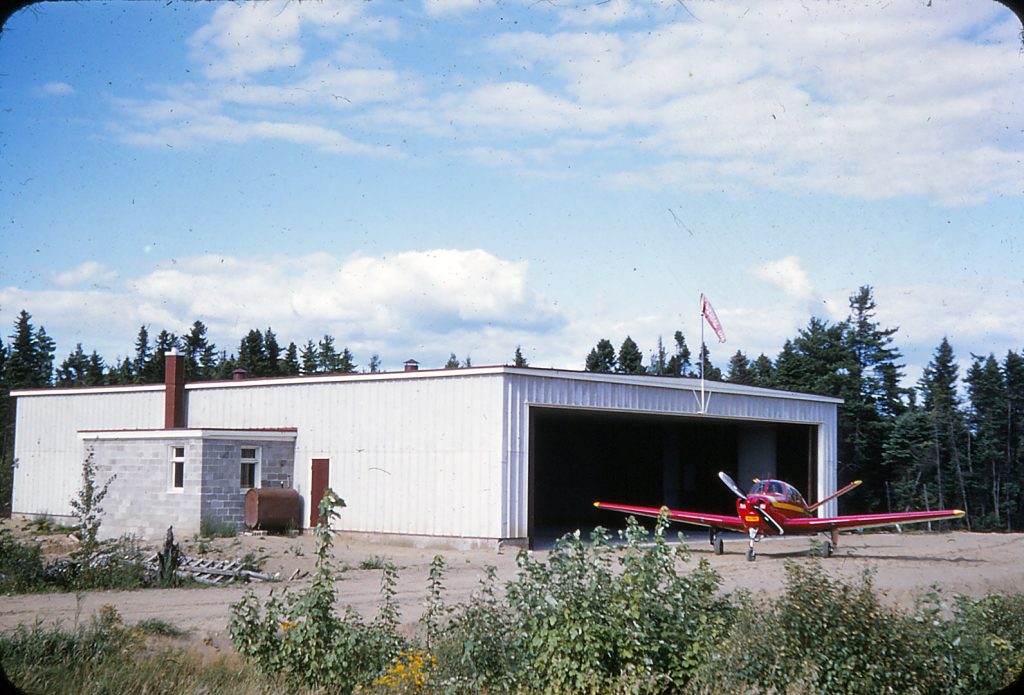
The Bonanza is a very capable airplane, but Stan felt the need for additional load capacity and the safety of a second engine. In May 1961 he purchased the first of five Beech Barons. The Baron is essentially a Bonanza with two engines. The B55 model would carry 1844 pounds of fuel, passengers and baggage compared to 1067 lbs of his Bonanza and cruise at 216 mph compared to 200 mph for the Bonanza. The Baron had extra baggage space in the nose and could seat 5. For Stan’s missions where he would often carry five adults and baggage, the Baron was a good fit. Beech made several variants of the Baron but the B55 model was Stan’s favorite and he stayed with that model. Most pilots today would agree with Stan that the B55 was the best Baron Beech built. Stan traded his planes about every four years getting much improved navigation and communications equipment.
He started working on his instrument rating in Nov. 1954. Getting that important rating would not be so quick. He finally took his Instrument check ride eight years later on April 12, 1962 in Montreal in his Baron CF-SBC. Having an instrument rating gave him considerably more flexibility in planning trips. Considering that the weather in the Maritimes is not the greatest in general and that aviation forecasting left a lot to be desired in the 1950’s, he managed surprisingly well flying over 1200 hours all in VFR (Visual Flight Rules) from 1954 to May 1962.
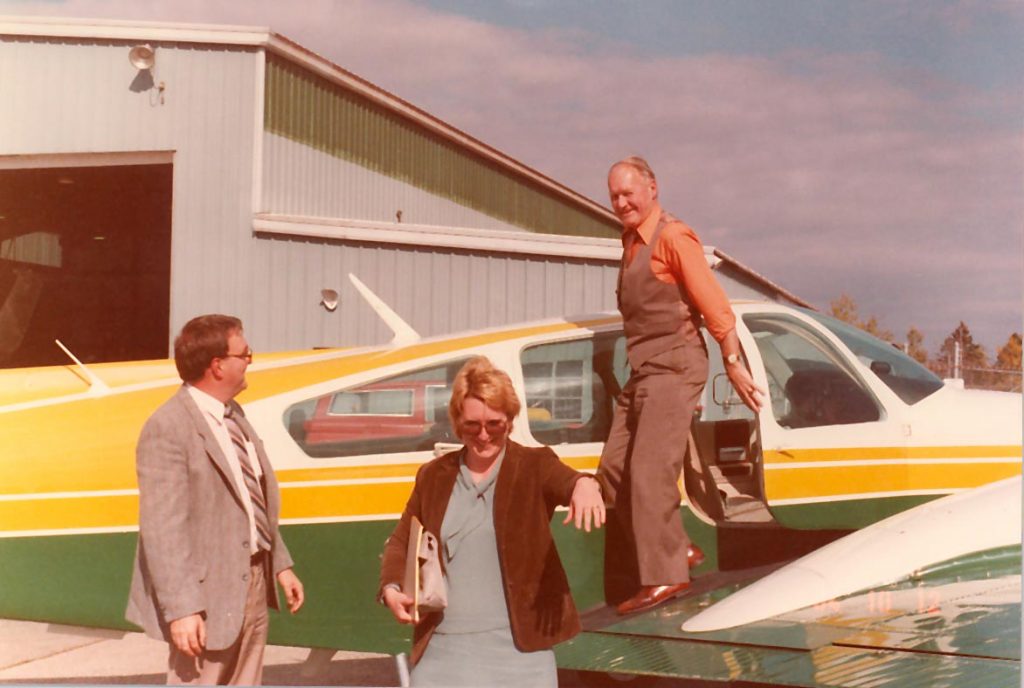
Stan’s use of his aircraft grew quickly, especially once he got his instrument rating in 1962. His peak flying years were during the 1960s and 1970s. His business flourished during this time and he was very involved in the establishment and operation of the Forest Hill Rehabilitation Center which, after his death, would be renamed The Stan Cassidy Rehabilitation Center. Many of his trips were to meet with doctors on new treatments for paraplegics and for transporting patients to clinics for treatment. The electrical contracting business changed in the 1980s and he made the decision to shrink his operation rather than expand to serve the new market conditions. By this time, wholesale distribution of electrical equipment had improved significantly reducing the need for personal interaction with vendors in distant places like Montreal, Toronto, and Boston. The plane was still useful, just not as critical to day-to-day business operations.
Stan was interested in anything that flew. In 1967 he did the necessary study and training to get familiar with a Lear Jet, piloting it from takeoff to 8 miles up at a speed of mach 0.8. He was the first in Canada to take this course. In 1968 he flew right seat in a Falcon Jet. Not long after the Concord, supersonic aircraft started flying, he flew on it from New York to Paris, just for the experience. He enjoyed visiting aviation museums like the Smithsonian Air and Space Museum in Washington, DC and the US Navy Aviation Museum in Pensacola, Florida.
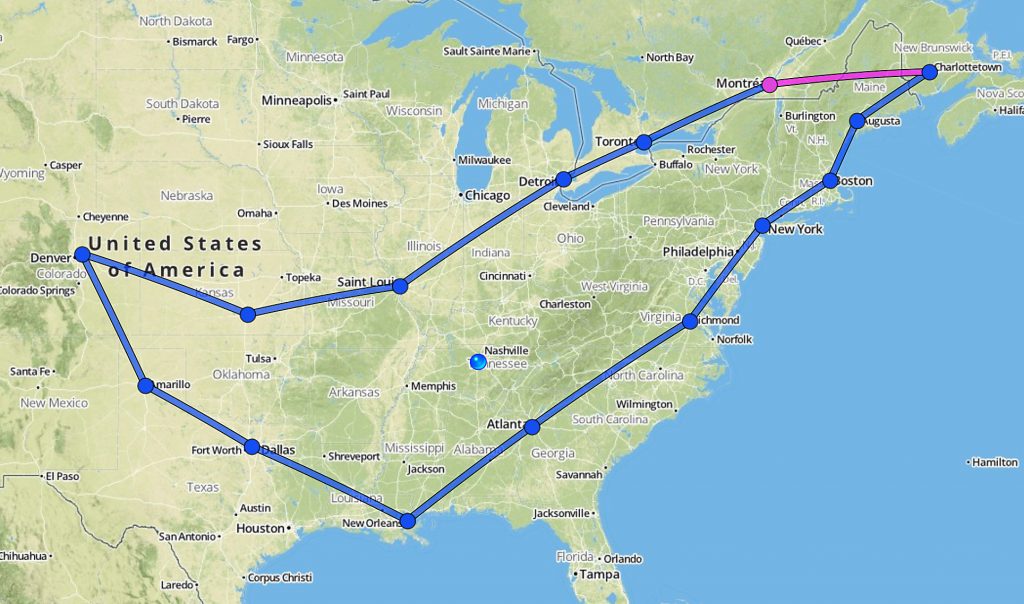
Some Interesting Trips
Popular destinations for Stan were Moncton, Saint John, Halifax, Montreal, Toronto, Boston, and New York. His first really long trip was in April 1956 to Denver and New Orleans with close friend and noted Fredericton architect, Ottis Logue, to the southwest U.S. They left Fredericton on April 8 in Bonanza CF-HTA returning on April 19, a 12-day, 5000 mile adventure–all done VFR.
| Apr 8 | Fredericton to Montreal Montreal to Toronto Island | 2:05 hrs 1:50 |
| Apr 9 | Toronto Island to Detroit Detroit to St. Louis | 1:30 3:00 |
| Apr 11 | St. Louis to Wichita Wichita to Denver | 2:30 2:55 |
| Apr 12 | Denver to Amarillo Amarillo to Dallas | 2:30 2:20 |
| Apr 13 | Dallas to New Orleans | 3:15 |
| Apr 16 | New Orleans to Atlanta Atlanta to Richmond Richmond to Teterboro | 2:45 2:45 2:00 |
| Apr 19 | Teterboro to Boston Boston to Fredericton | 1:15 2:20 |
| 12 days | 5000 miles | 33:00 hrs |
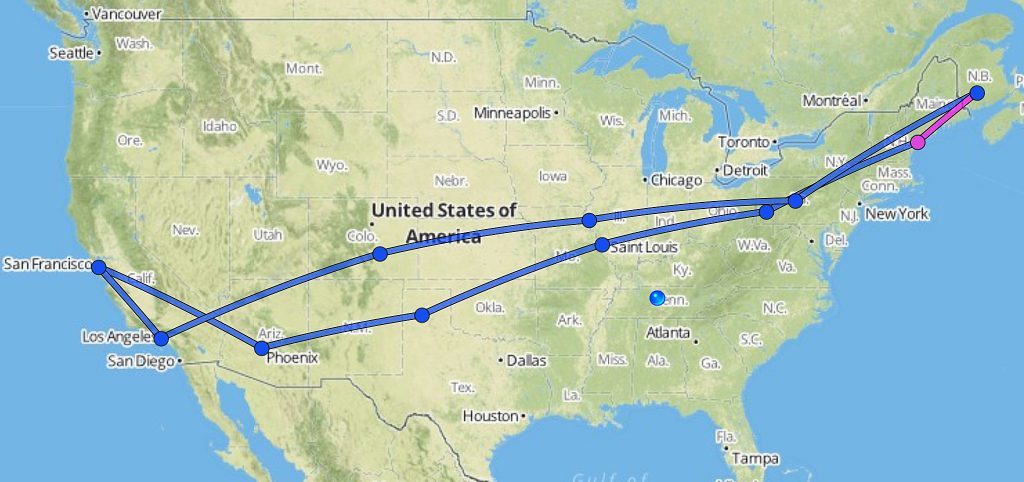
Another memorable trip was in Baron CF-SBC in December 1961 to California. Accompanying Stan were sons Peter and Brian, and, close friend and fellow Shriner, Charlie Fisher. The trip was in connection with the Shrine. This was the year Stan was Potentate of Luxor Shrine and was contemplating running for Imperial Potentate. They left Fredericton on December 26 returning on January 3. Highlights of the trip were attending the Rose Bowl parade and football game along with a visit to Disneyland in Los Angeles.
| Dec 26 | Fredericton to Portland Portland to Pittsburg Pittsburgh to St. Louis | 1:30 hrs 3:30 3:50 |
| Dec 27 | St. Louis to Amarillo Amarillo to Phoenix | 3:50 3:35 |
| Dec 28 | Phoenix to San Francisco | 3:45 |
| Dec 31 | San Francisco to Los Angeles | 2:15 |
| Jan 2 | Los Angeles to Pueblo Pueblo to Quincy, IL | 4:45 3:40 |
| Jan 3 | Quincy to Phillipsburg Phillipsburg to Fredericton | 3:20 3:15 |
| 9 days | 6530 miles | 37:15 hrs |
Heading South in Winter
In the early 1960s he and Elsie began making regular trips to Florida during the winter. They would rent a place at the Aldea Mar beach condominium complex in Venice from February to April. Stan would go for a week or two, Elsie would stay the entire time. Other family members would visit for a few weeks. She would often fly commercial one way from Bangor, Portland or Boston. He tried to purchase one of the villas at Aldea Mar but the deal fell through.
| Mar 1 – Mar 11, 1963 | Key West | Elsie Cassidy, Allen Cassidy |
| Feb 21 – Mar 6, 1964 | Nassau | Charlie Weyman, Reg Shanahan, Al Rioux |
| Mar 31 – Apr 5, 1975 | Venice | Wayne and Betty Wade, Nellie and Jean MacDowell |
| Mar 9 – Mar 11, 1976 | Venice | Elsie Cassidy, Archie, Robert and Bertha Miller |
| Mar 26 – Apr 3, 1976 | Venice | Gwen, Cathy and Heather Cassidy |
| Feb 16 – Feb 22, 1977 | Venice | |
| Apr 16 – Apr 22, 1977 | Venice | |
| Feb 16 – Feb 20, 1978 | Venice | Elsie Cassidy, George Cassidy, Jean Cassidy Archie Miller |
| Apr 11 – Apr 17, 1978 | Venice | |
| Jan 15 – Jan 22, 1979 | Venice | Elsie Cassidy, Archie Miller, W. Wolfe |
| Jan 18 – Jan 24, 1981 | Venice | Elsie Cassidy, Archie Miller, Ed McGinley |
Starting in 1988 when Peter and Gwen moved to Nashville, Tennessee, Stan and Elsie made this a regular destination. They made 5 trips to Nashville: Dec. 1988, Apr 1990, Jun 1991, Mar 1992, Dec 1992.
At one point Stan seriously considered flying his Baron across the Atlantic to Ireland. It would require installing long-range tanks in the cabin. Since the weather in the North Atlantic is not great at the best of times, it would require considerable flexibility in scheduling. The plan was eventually dropped. He visited Ireland several times, always flying commercially.
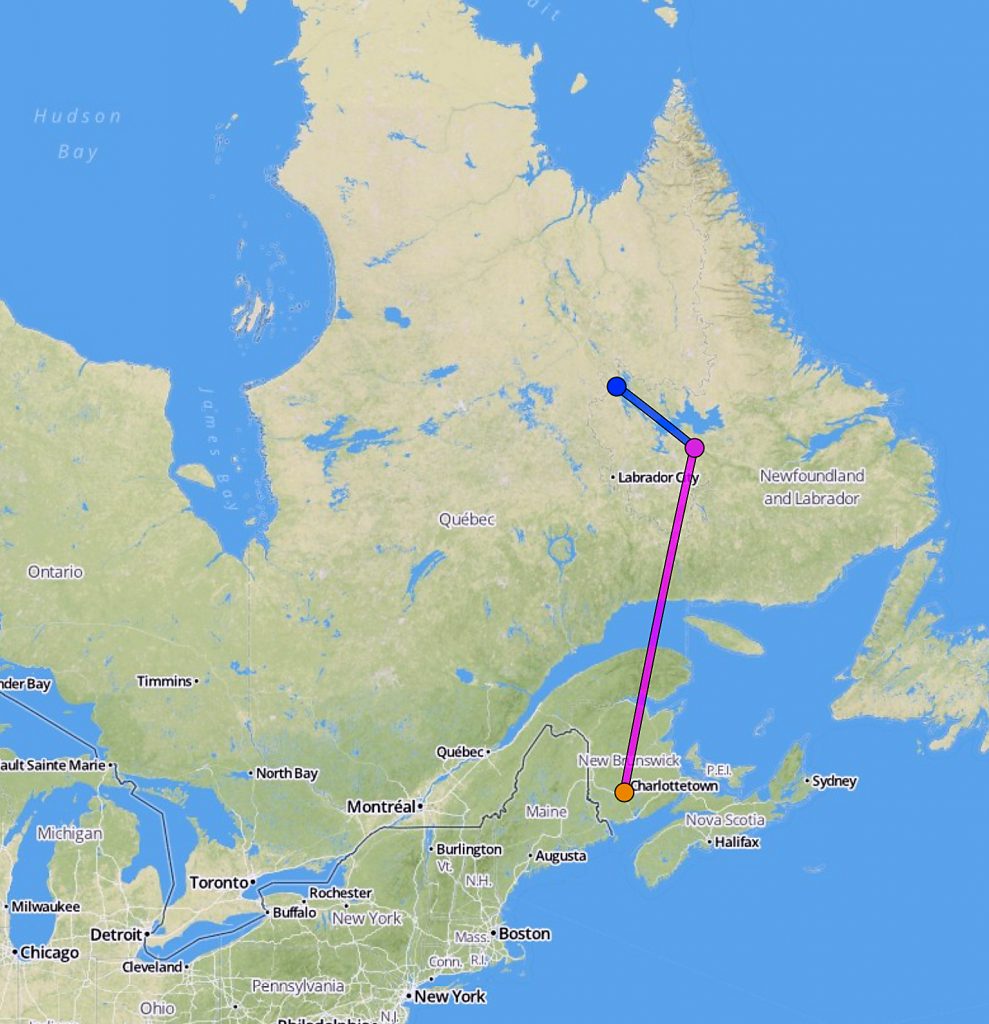
Let’s Go Fishing
Stan loved to salmon fish. He always carried fishing gear in the trunk of his car and knew where the best salmon fishing spots were. Having a plane allowed him to travel to places like northern Quebec wilderness where the salmon fishing is superb. On Aug. 11, 1974, Stan, along with his fishing buddies Joe Gorham, Al Tommy and Greg Samson, took the Baron CF-RSC 600 miles north of Fredericton to Schefferville in northern Quebec with a fuel stop at Churchill Falls. At Schefferville they chartered a bush plane to take them even deeper into the tundra. They froze the fish they caught on the permafrost to bring them back to Fredericton.
Some Challenging Flights
Flying as much as he did, Stan was bound to run into problems. Stan experienced at least one engine failure during his career. It was in one of his Barons (CF-SBC) on a flight from Ft. Lauderdale, Florida to Nassau on Feb. 23, 1964.
Stan, Reg Shanahan, Al Rioux and Charlie Weyman were on a trip to Nassau. The troubled flight on Feb. 23 lasted just 15 minutes. Reg Shanahan recounted the experience to Brian Cassidy in January 2013. The failure was during takeoff. The photo in the gallery above is from their return trip taken at Norfolk, Va on March 6 (L-R) Reg Shanahan, Charlie Weyman, Al Rioux, Stan.
“I (Reg) was in the right rear seat and noticed considerable black smoke coming from the right engine just prior to takeoff. This problem was apparently not noticed by Stan. I decided that this would probably clear once the engines were fully revved after takeoff and didn’t say anything. However just after takeoff, matters got worse (considerable black smoke) and I brought the problem to Stan and Charlie Weyman’s attention. Charlie was in the copilot seat. Charlie shouted out twice “Heavy smoke from the right engine” with particular on “the right” to make sure Stan would not shut down the wrong engine. Stan decided to shut the engine down immediately for fear of fire. While Stan was busy shutting down the engine and gaining control with one engine, Charlie took over communications and contacted the tower to say they had a problem and needed to return to the field. During the process of shutting down the failed engine the stall warning alarm sounded at which point Charlie shouted “Gen the nose down.” Charlie asked Stan if he wanted to declare an emergency and Stan said “No, everything is under control but we will need to land as soon as possible.” So Charlie continued the conversation with the tower and other traffic was held while they landed. They were then towed back to a hangar for inspection and repair. Two engine “pods” had failed and needed to be replaced but it would take a couple of days to get new ones from the Beechcraft factory. In the meantime, we recalled the name of a friend, Charlie Llewellyn, then owner of Wandlyn Inn chain of motels, and who had a winter home in Ft Lauderdale and they looked him up and had a great visit while consuming all his booze which didn’t make him very happy, apparently.”
From Stan’s log book we see that the repair was done quickly. Two days later, on Feb. 25, he made a 30 minute test flight with Pete Findlay (likely the lead mechanic who did the repairs), following which they departed for Nassau. Engine failure in a twin is a demanding situation and a condition for which pilots train extensively. Stan handled it well. Replacing two cylinders (pods as Reg Shanahan calls them) is a major repair that would cost about $5,000 in 2013 dollars and they were fortunate to get the work done in just two days. We have to give Stan and his friends, who were all pilots except Reg, extra marks for having the courage to depart on a 1:15 over water flight after a major aircraft repair and only a 30 minute test flight.
In his trip log we found a number of remarks concerning difficulties that are interesting especially those concerning failure of the cabin heater in the dead of winter. His use of an exclamation mark “!” is telling of the seriousness of the situation.
| Dec. 13, 1973 | Fredericton – Ottawa | Could not make Toronto. Bad Weather. They spent the night in Ottawa and went on to Toronto the next day. |
| Mar 3, 1974 | Toronto – Fredericton | Bad weather. Change in plan. |
| Nov 8, 1974 | Fredericton – | Bad weather. Had to return to Fredericton. [The intended destination is not identified. He flew 4:00 hrs so it was a long trip to nowhere.] |
| Mar 12, 1975 | Montreal – Toronto | Problems at Toronto re strike and taxiways not cleared! |
| Dec 11, 1975 | Fredericton – | 10:00 am – Weather bad in Halifax. FOG. [He flew 1:10 on this attempt.] |
| Dec 11, 1975 | Fredericton – | 1:00 pm – Halifax down FOG. [He flew 1:10 on this attempt. He finally got into Halifax the next day.] |
| Jan 6, 1978 | Montreal – Fredericton | Wanted to go to Toronto but weather went bad sooner than expected so came back to Fredericton. |
| Feb 11, 1979 | Boston – Fredericton | Heater would not work all the way home -23C (-9F) |
| Jun 5, 1981 | Fredericton – Ottawa | Landed Ottawa. Weather bad in Toronto, FOG. |
| Dec 22, 1981 | Fredericton – Bathurst | Could not land due to weather. Returned to Fredericton. |
| Jan 10, 1982 | Fredericton – Toronto | Very, very cold, gusty, snowy weather at Toronto. Heater quit +/- Bucky -33C (-27F). |
| Mar 8, 1984 | Portland – Toronto | Heater did not work during entire 3:00 hr flight! |
He also made note of numerous equipment failures such as radios, alternators, and flaps. These would be mostly an annoyance and inconvenience.
Stan was blessed with good health. Except for having both hips replaced, one at age 78, the other at 80, it was unusual for him to be sick. He recovered very quickly from his hip surgeries and was very pleased with the outcome. We don’t ever recall him being admitted to a hospital. As a testament to his good health, he passed his pilot medical at age 80 on January 13, 1993, only a month before his accident.
Stan’s flying interest was passed on down the family tree. Two sons, Peter and Brian, were active in Air Cadets and received their pilot licenses. Peter has owned several aircraft including a 2000 model A36 Bonanza N395SA. Grandson, Brian Jr. was also active in Air Cadets and became one of the officers of the Fredericton Squadron.
Aircraft Stan Owned
| Dates | Make | Model | Registration | Hours Flown |
| Apr 1954-Jun 1956 | Taylorcraft | BC12-D1X | CF-EHO | 63 |
| Aug 1954-Jan 1959 | Bonanza | E35 | CF-HTA | 576 |
| Jan 1959-May 1961 | Bonanza | J35 | CF-KSK | 440 |
| May 1961-Jun 1965 | Baron | 55 | CF-SBC | 1106 |
| Jun 1965-Jun 1969 | Baron | B55 | CF-SCV | 1035 |
| Jun 1969-Apr 1973 | Baron | B55 | CF-SCI | 582 |
| Apr 1973-Jun 1980 | Baron | B55 | CF-RSC | 1275 |
| Jul 1980-May 1993 | Baron | B55 | C-GSTM | 1056 |
Aircraft Stan Had Flown
| April | 1954 | CF-EHO | Taylorcraft |
| June | 1954 | N3425B | Bonanza D35 |
| August | 1954 | CF-HTA | Bonanza E35 |
| Dec | 1954 | CF-HCW | Piper Apache |
| May | 1955 | N8989A | Bonanza |
| July | 1956 | N4262D | Bonanza |
| Mar | 1957 | N5026B | Bonanza |
| May | 1957 | CF-JBJ | Piper Apache |
| July | 1957 | N9045B | Bonanza |
| Nov | 1957 | N5432D | Bonanza |
| Feb | 1958 | N8234D | Bonanza |
| Jan | 1959 | N259AA | Bonanza |
| Jan | 1959 | CF-KSK | Bonanza J35 |
| Apr | 1965 | N9404Y | Bonanza |
| May | 1961 | N1219Z | Baron |
| May | 1961 | CF-SBC | Baron 55 |
| Feb | 1962 | CF-PAM | Baron |
| Feb | 1962 | CF-JNQ | Beech D18 |
| Aug | 1963 | CF-KSQ | Bonanza |
| Aug | 1964 | CF-RJA | Baron |
| Aug | 1964 | CF-RHM | Beech Travelair |
| June | 1965 | CF-SCV | Baron 55 |
| Aug | 1966 | CF-SVJ | Turbo Commander |
| July | 1967 | N458LJ | Lear Jet |
| Nov | 1967 | N7815L | Queen Air |
| Dec | 1967 | CF-CGM | Turbo Baron |
| March | 1968 | N808F | Falcon |
| June | 1968 | CF-VAH | TC Baron 56 |
| Sept | 1968 | CF-XAO | Bonanza |
| Sept | 1968 | CF-WVF | Duke |
| Oct | 1968 | CF-FAR | King Air |
| Oct | 1968 | CF-XBP | D Baron |
| June | 1969 | CF-SCI | Baron 55 |
| Apr | 1973 | CF-RSC | Baron 55 |
| July | 1980 | C-GSTM | Baron 55 |






























